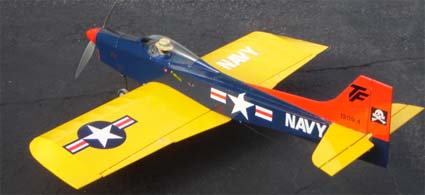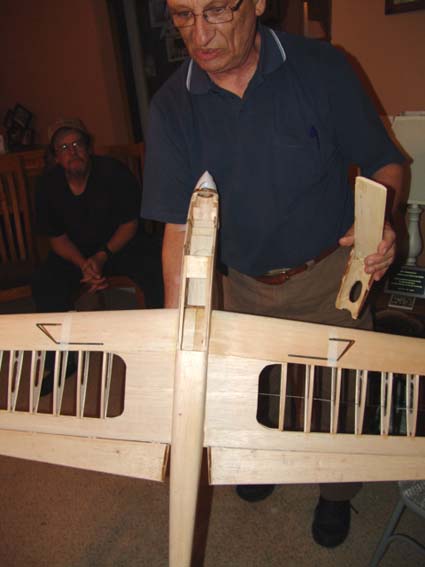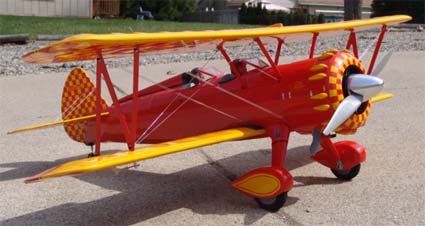 |
Flying High With Electric Power!
The Ampeer ON-LINE!
Fly the Future - Fly Electric! |
Site Table of Contents
| President: | Vice-President: | Secretary/Treasurer: |
| Ken Myers | Richard Utkan | Rick Sawicki |
| 1911 Bradshaw Ct. | 240 Cabinet | 5089 Ledgewood Ct. W. |
| Commerce Twp., MI 48390 | Milford, MI 48381 | Commerce Twp., MI 48382 |
| (248) 669-8124 | (248) 685-1705 | 248.685.7056 |
 | ||
| Board of Directors: | Board of Directors: | Ampeer Editor |
| David Stacer | Jack Lemon | Ken Myers |
| 16575 Brookland Blvd. | 8908 Sandy Ridge Dr. | 1911 Bradshaw Ct. |
| Northville, MI 48167 | White Lake, MI 48386 | Walled Lake, MI 48390 |
| 248.924.2324 | 248.698.4683 | 248.669.8124 |
| Mailed Ampeer subscriptions are no longer available | ||
| The Next Meeting:
Date: May 1 Time: 10:00 a.m. Place: Midwest 7 Mile Rd. Flying Field | ||
|
From John McClure
Hi Ken, I am a new convert to model planes and have recently stumbled upon your web site for the Ampeer and live in a delightful bay side village on the south coast of New South Wales Australia. After accessing some of your back issues on the web it seems that you would be a great source for some much needed help.
Regards,
Hi John, Selecting a power system for an old-timer can be a daunting task. The Red Zephyr was designed by Herb Greenberg and flown at the 1936 NATS (U.S. National Championships).
www.rcgroups.com/forums/showthread.php?t=915223&highlight=e+flite+apprentice www.rcgroups.com/forums/showthread.php?t=1150468&highlight=e+flite+apprentice www.rcgroups.com/forums/showthread.php?t=913197&highlight=e+flite+apprentice
Hope this helps,
Put This One On Your Event Schedule!
The Balsa Butchers will once again be hosting the "Keith Shaw Birthday Party Electric Fly-In" at their field near Coldwater, MI. The event will take place on June 5 and 6, 2010.
|
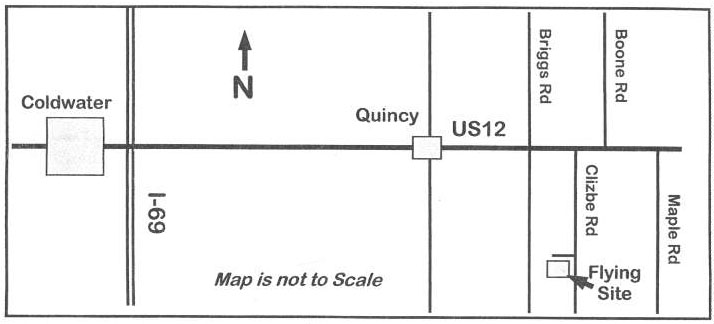
|
I love this meet. There is a lot of laid back flying with some of the Midwest's best pilots, Electric Flight Designers, Builders and Authors. I wouldn't miss it! It is a lot of fun for everyone with an interest in electric flight. KM Information Regarding the 2010 Mid-Ammerica Electric Flies The 2010 Mid-America Electric Flies (Mid-Am) will be held on July 10 & 11 at the MRCS 7 mile Rd. flying field in Salem Twp., MI. Top Flite Contender Maiden
Hi Ken, I felt well enough to fly today. I maidened the Contender ---WOW! I think it is going to be my "go to" plane for this season. It took off like a rocket -- straight up! Oops, full down trim. Perfect. Two clicks right aileron -- dead-on. I flew most of the flight at 2/3 throttle. Man this baby gets SMALL in a HURRY!
Stalls are a non-event. Maybe that was because she was slightly nose heavy on the first flight. It still took almost no elevator when inverted so the CG (fore-and-aft balance) must be close.
The April EFO Meeting The April 1 EFO meeting was held at Ken's house. Once again, the turnout was very good, and we all had a great time. Many of us were excited because the "official flying season opener" the Toledo RC Expo was coming up fast. Rick Sawicki brought his latest control line electrically powered model, the Legacy, to share with us. Rick has been doing electric control line for at least six years now. He was, in his younger days, a top competitor in control line, along with his father.
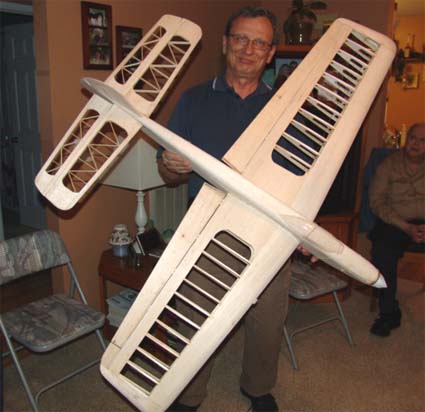
He has built a motor hatch and mounting system so that he can easily change between an AXI, Scorpion and Arrowind outrunner. You can see his special mount in his hand in the picture of the three motors. It has an AXI mounted to it right now. 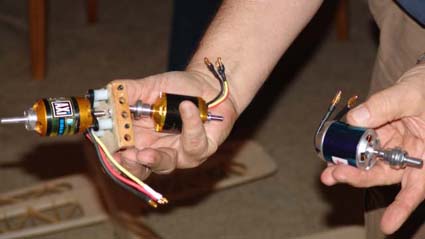 Rick uses a standard Castle Creations ESC that is controlled by his timer/controller. He uses the helicopter governor mode to keep his up-lines and down-lines at the same speed. The Will Hubin timer controls the voltage to the ESC and the time. It sells for about $23.
James Frolik, who lives in Cologne, Germany, sent Ken a DVD of John Borgen's DC-9-21. Jim sent along the following via email as a background. About ten years ago an R/C modeling acquaintance introduced me to John Borgen of Copenhagen, Denmark. Earlier John had undertaken an ambitious project to build an EDF model replica of Scandinavian Airlines System's (SAS) very first Airbus, an A300-B4. Ironically he was not a crazy EDF modeler himself, but just a casual eflight hobbyist, and, most important, an occasional R/C scale modeling judge. Yet he had a burning desire to build an electric ducted fan modelÑactually a semi-tribute to SAS-of a commercial jet that is something not really seen at scale competition events.
Part 1 www.vimeo.com/7043207 Part 2 www.vimeo.com/7043579 Part 3 www.vimeo.com/9814202 Regards,
James also sent along this nice still of the model in flight. 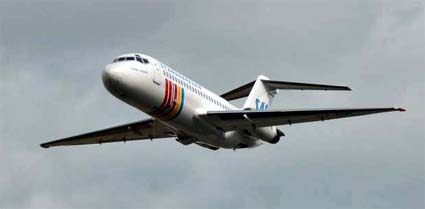 During the watching of the video, there were plenty of snacks. Once the group had completed that DVD, Ken put on his video "Electric Flying in the 90's". All of the footage on VCR tape was captured prior to 1990. Some of the newer EFO members had not seen these archival videos and were amazed at what many of use were actually doing with electric power before 1990. Thank you Keith Shaw!
Some Questions about "A123" 2300mAh Cells
Happy Easter. Hope you don't mind fielding a few questions but I am transitioning from Ni-cads to lithium after resisting for some time and need some advice. Truth be known, I need lots of advice.
I'm building a Cessna 195. It has a wingspan of 59 inches and a predicted ready to fly (RTF) weight of 5.0 -5.5 pounds with a wing cube loading (CWL) of 12.29 oz./cu.ft. I am not a very good pilot, so your data on CWL says I may have my hands full.
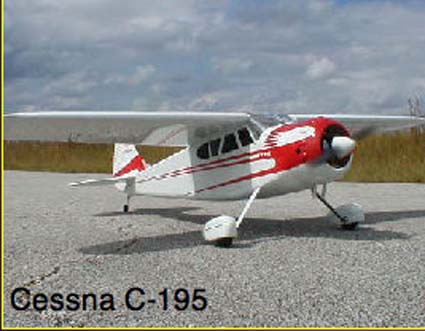
Photo from hobbyhangar.com Web site The "kit" is a set of plans and all of the laser cut wood. The rest I have to scrounge. In any event, this overweight beauty can't carry the weight of Ni-cads, which leads me to A123s. I don't care for all the inconveniences of Li-poly batteries.
I've made up all of my A123 packs from DEWALT packs, except my first pack, a 6S, which I purchased from Big E RC. I can tell you about Dave Thacker though. He is top notch, first rate, a great guy who stands behind his products! Radical RC is excellent to deal with. I'm sure that Dave can provide you a pre-made flight pack or two at a fair price with excellent work. I've known Dave for many, many years now and Im more impressed with him and his business each time we meet. He is our major vendor at the Mid-Am. He'll be at Toledo if you are driving down. KM I need to buy a charger that will handle [I think] Li-poly batteries and A123s with a built-in balancer and up to five cells. What would you suggest? Not the least expensive, but one of the absolutely easiest to use with very good power out is the FMAdirect CellPro 10S. I've had experience with several other "upscale chargers" and this is by far the simplest to use that I have personally run across. While not cheap, it is a great value. Be sure to find out what type of balancer plugs Dave is putting on your packs. You'll need that info to order the correct adapter for the CellPro 10S. Using the CellPro 10S at 10 amps, you should be able to charge an empty "A123" 2300mAh pack in less than 15 minutes. KM Just one more question before I stop burning up all your time. Compared to Ni-cads how much cooling air do "A123s" need? All batteries need cooling, how much depends on the ambient temperature and how much work you are asking them to do. Lithium based cells, in general, like to run a little warm for best power. A little warm means not cold. Don't read that as more than a little warm, like warm or hot! Try to get as much cooling over them as you would Ni-Cads. If it is a bit less, that probably won't be significant to their lifespan. These really are the perfect transition cells for us old Ni-Cad/NiMH users. They are lighter than what we were used to using and just about as maintenance free. They really do need balancing every so often, especially at first. If you decide to go with the CellPro 10S, then you'll always be balancing your packs as the balance lead must always be connected for the 10S to charge. No problem really. That is just the way it is. KM More Thoughts on Motor Nomenclature
Hi Ken, How are you doing? I hope your shoulder is healing fast since you are starting your flying season by now. The shoulder is coming along okay and should not interfere with flying too much, but I can't hand launch now. Not a real problem, but I was the go to guy for hand launches. KM Here in southern Brazil we barely felt the equinox changes, our temperatures are still around mid seventies. Only in July we are expected to get some forties and thirties but not less than that. Flying is all year round, when we have the time for that. Right now I'm quite busy, traveling a lot and flying a little less than intended.
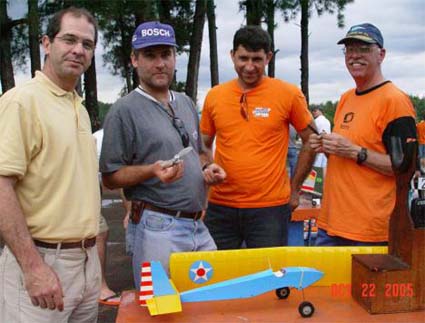 The other picture is from my former .25 powered Sturdy Birdy that now carries a Dualsky XM3536CA-8 in the nose, this motor does not follow the proposed standard as it measures 35mm diameter and 36mm length overall, bell and base included. I had not yet disassembled it to take stator numbers. I am the last one from left to right in both photos. 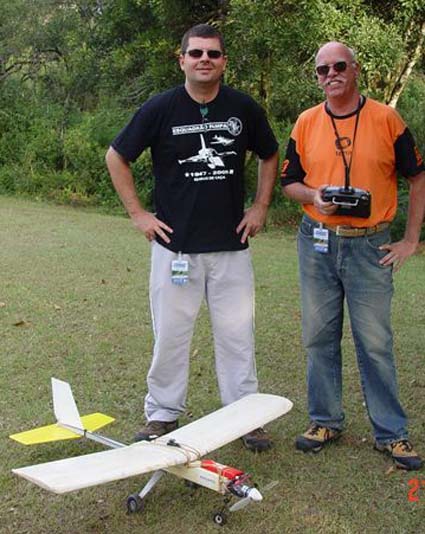 Take care and enjoy your flying and EFO Meetings! My Super Stearman is Ready to Take to the Air
My conversion of the E-flite PT-17 Stearman into Super Stearman N56772 is ready for its maiden flight. I have posted a complete description of the conversion on RC Groups at www.rcgroups.com/forums/showthread.php?t=1222582
|
To Reach Ken Myers, you can land mail to the address at the top of the page. My E-mail
address is:
KMyersEFO@mac.com
EFO WEBsite: http://homepage.mac.com/KMyersEFO/

